Enhanced Mechanical Properties of PUMA/SiO2 Ceramic Composites via Digital Light Processing
Abstract
:1. Introduction
2. Materials and Methods
2.1. Materials
2.2. Additive Manufacturing
2.3. Rheological Test
2.4. Mechanical Tests
2.5. Thermal Tests
2.6. Other Characterizations
3. Results and Discussion
3.1. Additive Manufacturing of PUMA/SiO2 Composites
3.2. Rheological Test Results
3.3. Mechanical Test Results
3.3.1. Hardness Test Results
3.3.2. Bending Test Results
3.3.3. Tensile Test Results
3.4. Thermal Test Results
3.4.1. Thermogravimetric Analysis
3.4.2. Thermal Diffusivity Test
3.5. FT-IR Test Results
4. Conclusions
- Surface hardness: PUMA/SiO2 composites with a 37.5 wt% SiO2 composition exhibited the highest hardness values with less sensitivity to processing conditions. In contrast, composites with lower SiO2 contents displayed inferior hardness and larger deviations.
- Flexural properties: Elevated vat temperatures (45 °C) were found to degrade both flexural modulus and strength. In contrast, composites with a SiO2 content of 37.5 wt% demonstrated the highest flexural modulus, surpassing twice that of the pure PUMA sample.
- Tensile properties: PUMA/SiO2 composites with high SiO2 contents, exceeding 28.5 wt%, exhibited linear elastic behavior with improved tensile strength while the pure PUMA sample exhibited viscoelastic behavior. Notably, maintaining a low vat temperature (less than 35 °C) ensured high tensile strength for PUMA/SiO2 composites.
- Thermal properties: The inclusion of SiO2 particles increased thermal conductivity and diffusivity, revealing that a 37.5 wt% SiO2 composition exhibited the highest values. TGA tests indicated that a larger quantity of SiO2 particles ensured a more uniform dispersion during the AM process, contributing to improvements in mechanical properties.
Author Contributions
Funding
Data Availability Statement
Conflicts of Interest
References
- Filser, F.; Kocher, P.; Gauckler, L.J. Net-shaping of ceramic components by direct ceramic machining. Assem. Autom. 2003, 23, 382–390. [Google Scholar] [CrossRef]
- Ayode, O.T.; Ugochukwu, O.P.; Chen, G.; Li, Y.; Onyeka, O.M.; Li, S. Advanced ceramic components: Materials, fabrication, and applications. J. Ind. Eng. Chem. 2020, 85, 34–65. [Google Scholar] [CrossRef]
- Robinson, S.K.; Paul, M.R. Debinding and sintering solutions for metals and ceramics. Met. Powder Rep. 2001, 56, 24–34. [Google Scholar] [CrossRef]
- Chen, Z.; Li, Z.; Li, J. 3D printing of ceramics: A review. J. Eur. Ceram. Soc. 2019, 39, 661–687. [Google Scholar] [CrossRef]
- Zocca, A.; Colombo, P.; Gomes, C.M.; Günster, J. Additive manufacturing of ceramics: Issues, potentialities, and opportunities. J. Am. Ceram. Soc. 2015, 98, 1983–2001. [Google Scholar] [CrossRef]
- Moon, J.; Grau, J.E.; Knezevic, V.; Cima, M.J.; Sachs, E.M. Ink-jet printing of binders for ceramic components. J. Am. Ceram. Soc. 2002, 85, 755–762. [Google Scholar] [CrossRef]
- Zhang, W.; Melcher, R.; Travitzky, N.; Bordia, R.K.; Greil, P. Three-dimensional printing of complex-shaped alumina/glass composites. Adv. Eng. Mater. 2009, 11, 1039–1043. [Google Scholar] [CrossRef]
- Travitzky, N.; Bonet, A.; Dermeik, B. Additive manufacturing of ceramic-based materials. Adv. Eng. Mater. 2014, 16, 729–754. [Google Scholar] [CrossRef]
- Chavez, L.A.; Ibave, P.; Wilburn, B. The influence of printing parameters, post-processing, and testing conditions on the properties of binder jetting additive manufactured functional ceramics. Ceramics 2020, 3, 65–77. [Google Scholar] [CrossRef]
- Tang, H.H.; Chiu, M.L.; Yen, H.C. Slurry-based selective laser sintering of polymer-coated ceramic powders to fabricate high strength alumina parts. J. Eur. Ceram. Soc. 2011, 31, 1383–1388. [Google Scholar] [CrossRef]
- Shahzad, K.; Deckers, J.; Zhang, Z.; Kruth, J.P.; Vleugels, J. Additive manufacturing of zirconia parts by indirect selective laser sintering. J. Eur. Ceram. Soc. 2014, 34, 81–89. [Google Scholar] [CrossRef]
- Deckers, J.P.; Shahzad, K.; Cardon, L.; Rombouts, M.; Vleugels, J.; Kruth, J.P. Shaping ceramics through indirect selective laser sintering. Rapid Prototyp. J. 2016, 22, 544–558. [Google Scholar] [CrossRef]
- Kumar, S. Manufacturing of WC–Co moulds using SLS machine. J. Mater. Process. Technol. 2009, 209, 3840–3848. [Google Scholar] [CrossRef]
- Mohamed, O.A.; Masood, S.H.; Bhowmik, J.L. Optimization of fused deposition modeling process parameters: A review of current research and future prospects. Adv. Manuf. 2015, 3, 42–53. [Google Scholar] [CrossRef]
- Allahverdi, M.; Danforth, S.C.; Jafari, M.; Safari, A. Processing of advanced electroceramic components by fused deposition technique. J. Eur. Ceram. Soc. 2001, 21, 1485–1490. [Google Scholar] [CrossRef]
- Iyer, S.; McIntosh, J.; Bandyopadhyay, A.; Langrana, N.; Safari, A.; Danforth, S.; Clancy, R.; Gasdaska, C.; Whalen, P. Microstructural characterization and mechanical properties of Si3N4 formed by fused deposition of ceramics. Int. J. Appl. Ceram. Technol. 2008, 5, 127–137. [Google Scholar] [CrossRef]
- Khatri, B.; Lappe, K.; Habedank, M.; Mueller, T.; Megnin, C.; Hanemann, T. Fused deposition modeling of ABS-Barium Titanate composites: A simple route towards tailored dielectric devices. Polymers 2018, 10, 666. [Google Scholar] [CrossRef]
- Smirnov, A.; Terekhina, S.; Tarasova, T.; Hattali, L.; Grigoriev, S. From the development of low-cost filament to 3D printing ceramic parts obtained by fused filament fabrication. Int. J. Adv. Manuf. Technol. 2023, 128, 511–529. [Google Scholar] [CrossRef]
- Rashid, A.; Ahmed, W.; Khalid, M.Y.; Koç, M. Vat photopolymerization of polymers and polymer composites: Processes and applications. Addit. Manuf. 2021, 47, 102279. [Google Scholar] [CrossRef]
- Quan, H.; Zhang, T.; Xu, H.; Luo, S.; Nie, J.; Zhu, X. Photo-curing 3D printing technique and its challenges. Bioact. Mater. 2020, 5, 110–115. [Google Scholar] [CrossRef]
- Bae, C.J.; Halloran, J.W. Integrally cored ceramic mold fabricated by ceramic stereolithography. Int. J. Appl. Ceram. Technol. 2011, 8, 1255–1262. [Google Scholar] [CrossRef]
- Kirihara, S.; Niki, T. Three-dimensional stereolithography of alumina photonic crystals for terahertz wave localization. Int. J. Appl. Ceram. Technol. 2015, 12, 32–37. [Google Scholar] [CrossRef]
- Lian, Q.; Sui, W.; Wu, X.; Yang, F.; Yang, S. Additive manufacturing of ZrO2 ceramic dental bridges by stereolithography. Rapid Prototyp. J. 2018, 24, 114–119. [Google Scholar] [CrossRef]
- Stampfl, J.; Schwentenwein, M.; Homa, J.; Prinz, F.B. Lithography-based additive manufacturing of ceramics: Materials, applications and perspectives. MRS Commun. 2023, 13, 786–794. [Google Scholar] [CrossRef]
- Chaudhary, R.; Fabbri, P.; Leoni, E.; Mazzanti, F.; Akbari, R.; Antonini, C. Additive manufacturing by digital light processing: A review. Prog. Addit. Manuf. 2022, 8, 331–351. [Google Scholar] [CrossRef]
- Wei, Y.; Zhao, D.; Cao, Q. Stereolithography-based additive manufacturing of high-performance osteoinductive calcium phosphate ceramics by a digital light-processing system. ACS Biomater. Sci. Eng. 2020, 6, 1787–1797. [Google Scholar] [CrossRef]
- Terner, M. Innovative 3D-manufacturing of complex ceramic parts by means of commercial digital light processing apparatus. J. Weld. Join. 2019, 37, 369–377. [Google Scholar] [CrossRef]
- Chaudhary, R.; Akbari, R.; Antonini, C. Rational design and characterization of materials for optimized additive manufacturing by digital light processing. Polymers 2023, 15, 287. [Google Scholar] [CrossRef]
- Kim, T.Y.; Park, S.H.; Park, K. Development of functionally graded metamaterial using selective polymerization via digital light processing additive manufacturing. Addit. Manuf. 2021, 47, 102254. [Google Scholar] [CrossRef]
- Truxova, V.; Safka, J.; Seidl, M.; Kovalenko, I.; Volesky, L.; Ackermann, M. Ceramic 3d printing: Comparison of SLA and DLP technologies. MM Sci. J. 2020, 2020, 3905–3911. [Google Scholar] [CrossRef]
- Goldberg, M.; Obolkina, T.; Smirnov, S. The influence of Co additive on the sintering, mechanical properties, cytocompatibility, and digital light processing based stereolithography of 3Y-TZP-5Al2O3 ceramics. Materials 2020, 13, 2789. [Google Scholar] [CrossRef] [PubMed]
- Zhao, W.; Wang, C.; Xing, B.; SShe, M.; Zhao, Z. Mechanical properties of zirconia octet truss structures fabricated by DLP 3D printing. Mater. Res. Express 2020, 7, 085201. [Google Scholar] [CrossRef]
- He, C.; Ma, C.; Li, X. Polymer-derived SiOC ceramic lattice with thick struts prepared by digital light processing. Addit. Manuf. 2020, 35, 101366. [Google Scholar] [CrossRef]
- Huang, R.J.; Jiang, Q.G.; Wu, H.D. Fabrication of complex shaped ceramic parts with surface-oxidized Si3N4 powder via digital light processing based stereolithography method. Ceram. Int. 2019, 45, 5158–5162. [Google Scholar] [CrossRef]
- Schmidt, J.; Colombo, P. Digital light processing of ceramic components from polysiloxanes. J. Eur. Ceram. Soc. 2018, 38, 57–66. [Google Scholar] [CrossRef]
- Sun, Y.; Li, M.; Jiang, Y. High-quality translucent alumina ceramic through digital light processing stereolithography method. Adv. Eng. Mater. 2021, 23, 2001475. [Google Scholar] [CrossRef]
- Zhang, D.; Yang, Y.; Rao, W.F.; Zhang, D.; Yang, Y.; Rao, W.F. Parameter optimization for printing barium titanate piezoelectric ceramics through digital light processing. Micromachines 2023, 14, 1146. [Google Scholar] [CrossRef] [PubMed]
- Corcione, C.E.; Greco, A.; Montagna, F.; Licciulli, A.; Maffezzoli, A. Silica moulds built by stereolithography. J. Mater. Sci. 2005, 40, 4899–4904. [Google Scholar] [CrossRef]
- Chartier, T.; Badev, A.; Abouliatim, Y.; Lebaudy, P.; Lecamp, L. Stereolithography process: Influence of the rheology of silica suspensions and of the medium on polymerization kinetics—Cured depth and width. J. Eur. Ceram. Soc. 2012, 32, 1625–1634. [Google Scholar] [CrossRef]
- Zhou, W.; Li, D.; Chen, Z. The influence of ingredients of silica suspensions and laser exposure on UV curing behavior of aqueous ceramic suspensions in stereolithography. Int. J. Adv. Manuf. Technol. 2011, 52, 575–582. [Google Scholar] [CrossRef]
- Kićević, D.; Gašić, M.; Marković, D. A statistical analysis of the influence of processing conditions on the properties of fused silica. J. Eur. Ceram. Soc. 1996, 16, 857–864. [Google Scholar] [CrossRef]
- Dehghani, P.; Soleimani, F. Effect of cristobalite content on physical, dielectric constant, and bending strength of fused silica ceramics formed by slip casting method. Adv. Ceram. Prog. 2021, 7, 16–22. [Google Scholar] [CrossRef]
- ISO 178:2019; Plastics—Determination of Flexural Properties. International Organization for Standardization: Geneva, Switzerland, 2019.
- ASTM D683-14; Standard Test Method for Tensile Properties of Plastics. American Society for Testing and Materials: West Conshohocken, PA, USA, 2017.
- ASTM E1461-13; Standard Test Method for Thermal Diffusivity by the Flash Method. American Society for Testing and Materials: West Conshohocken, PA, USA, 2022.
- Stefan, E.; Didriksen, T.; Sunde, T.O.; Fontaine, M.L.; Ræder, H.; Rørvik, P.M. Effects of powder properties on the 3D printing of BaTiO3 ceramic resins by stereolithography. Prog. Addit. Manuf. 2023, 8, 1641–1651. [Google Scholar] [CrossRef]
- Lin, C.H.; Lin, Y.M.; Lai, Y.L.; Lee, S.Y. Mechanical properties, accuracy, and cytotoxicity of UV-polymerized 3D printing resins composed of Bis-EMA, UDMA, and TEGDMA. J. Prosthet. Dent. 2020, 123, 349–354. [Google Scholar] [CrossRef] [PubMed]
- Bakar, A.A.; Zainuddin, M.Z.; Abdullah, S.M. The 3D printability and mechanical properties of polyhydroxybutyrate (PHB) as additives in urethane dimethacrylate (UDMA) blends polymer for medical application. Polymers 2022, 14, 4518. [Google Scholar] [CrossRef] [PubMed]
- Achilias, D.S.; Karabela, M.M.; Sideridou, I.D. Thermal degradation of light-cured dimethacrylate resins: Part I. Isoconversional kinetic analysis. Thermochim. Acta 2008, 472, 74–83. [Google Scholar] [CrossRef]
- Fantino, E.; Chiappone, A.; Roppolo, I. 3D printing of conductive complex structures with in situ generation of silver nanoparticles. Adv. Mater. 2016, 28, 3712–3717. [Google Scholar] [CrossRef]
- Du, M.; Zheng, Y. Degree of conversion and mechanical properties studies of UDMA based materials for producing dental posts. Polym. Compos. 2008, 29, 623–630. [Google Scholar] [CrossRef]
- Ellerbrock, R.; Stein, M.; Schaller, J. Comparing amorphous silica, short-range-ordered silicates and silicic acid species by FTIR. Sci. Rep. 2022, 12, 11708. [Google Scholar] [CrossRef]
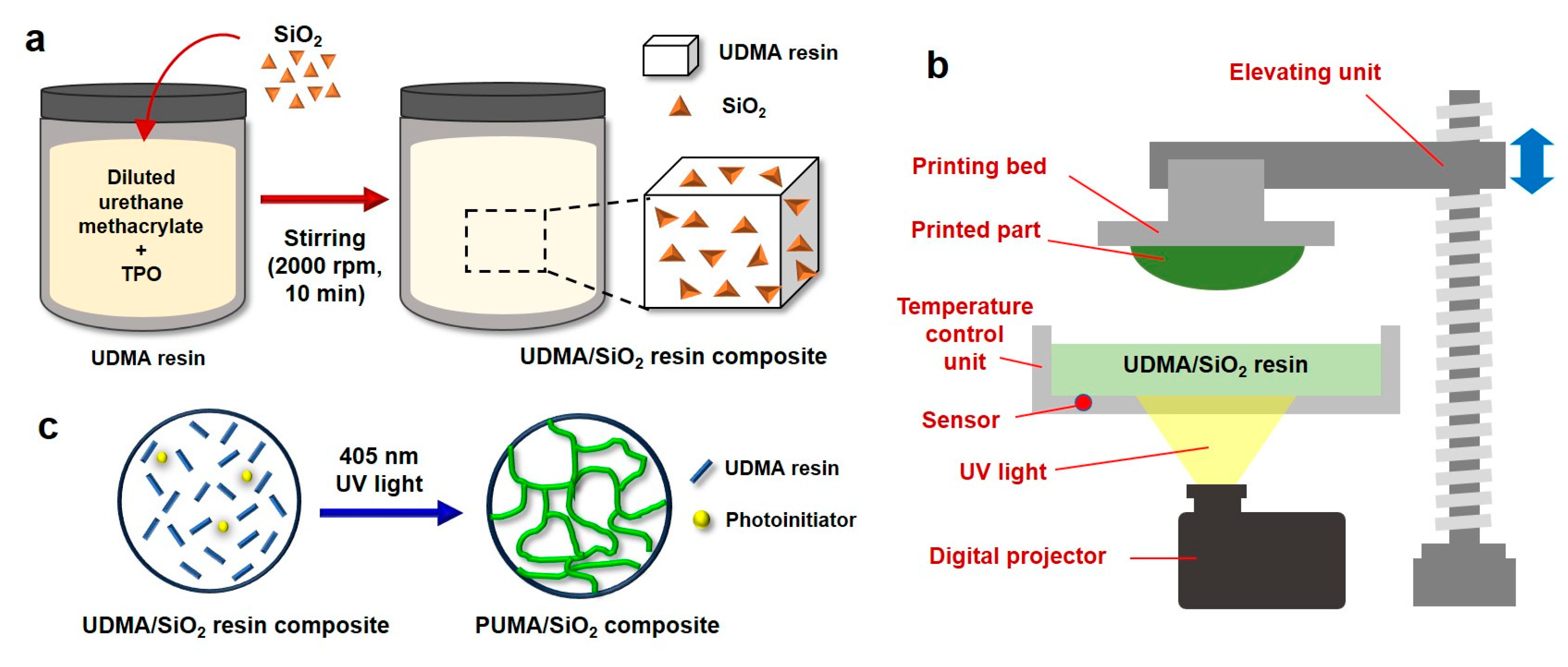


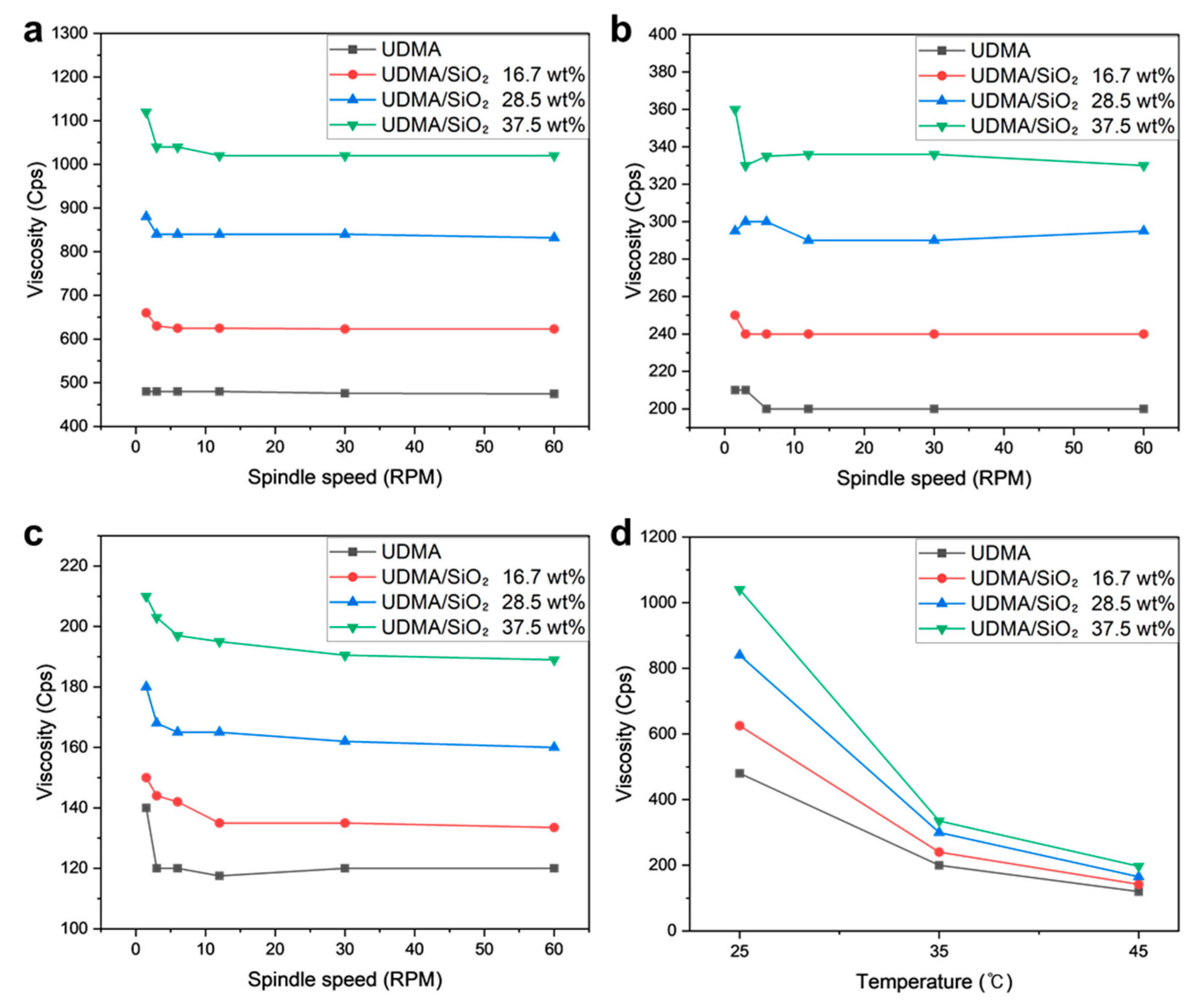
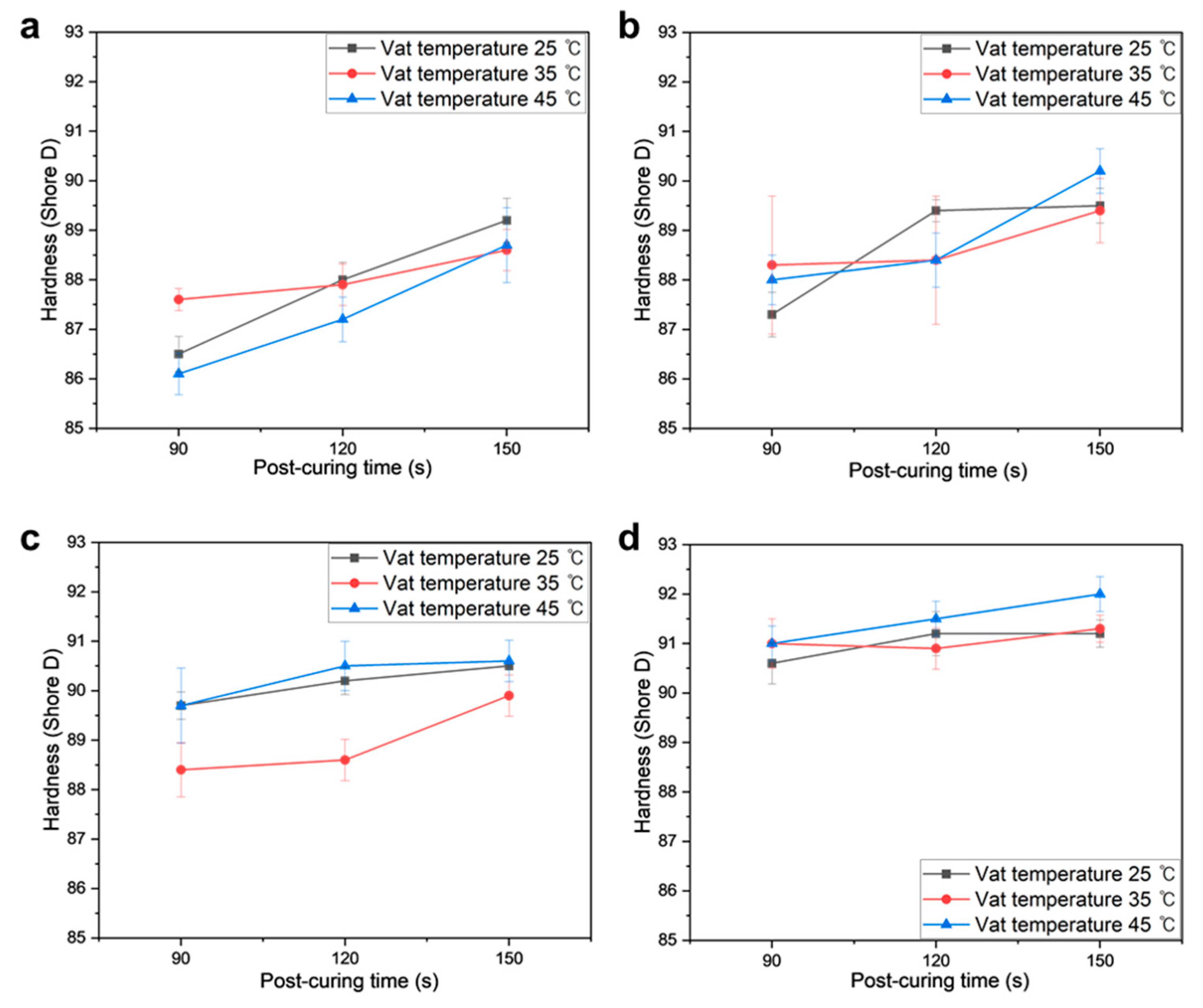
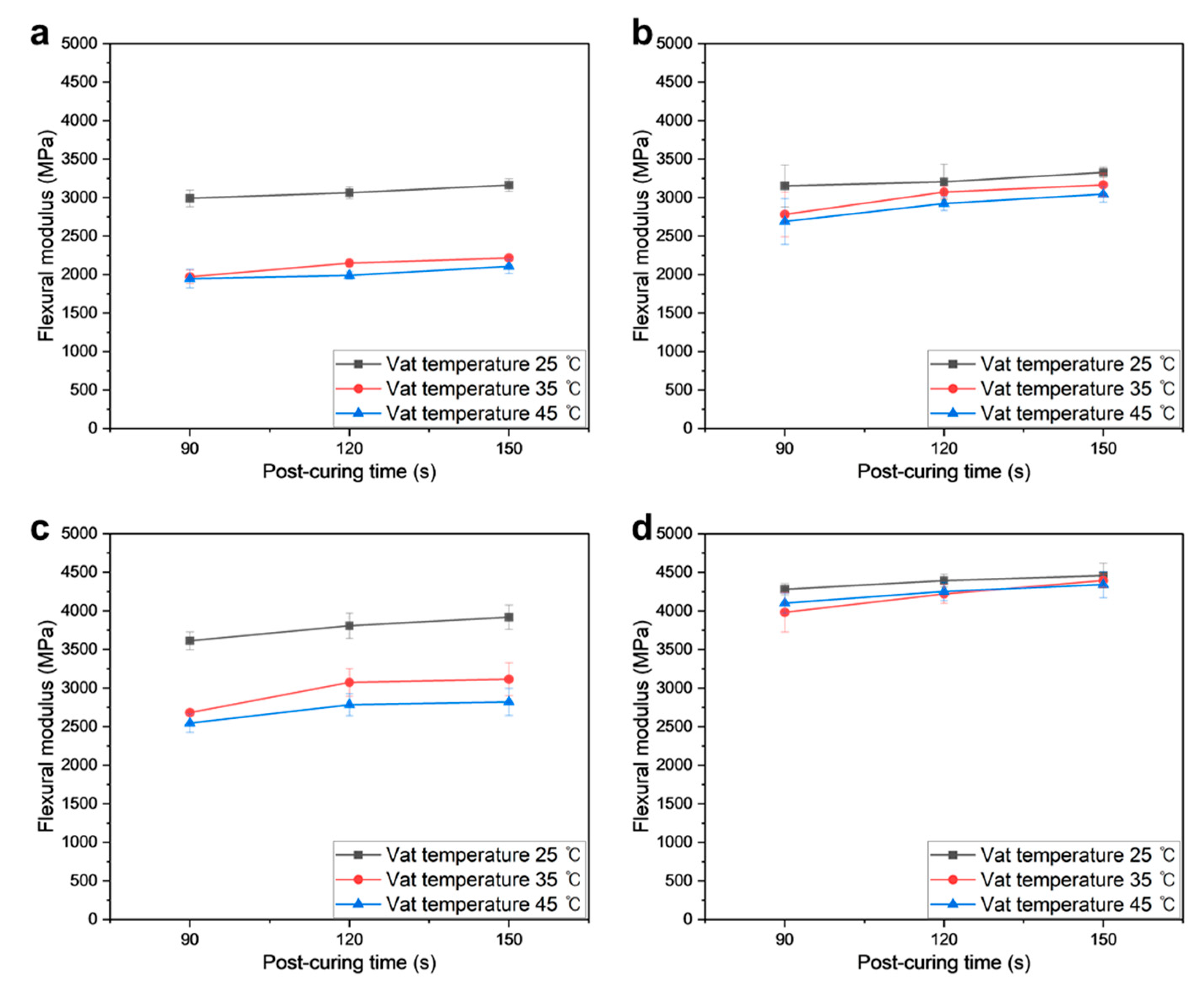

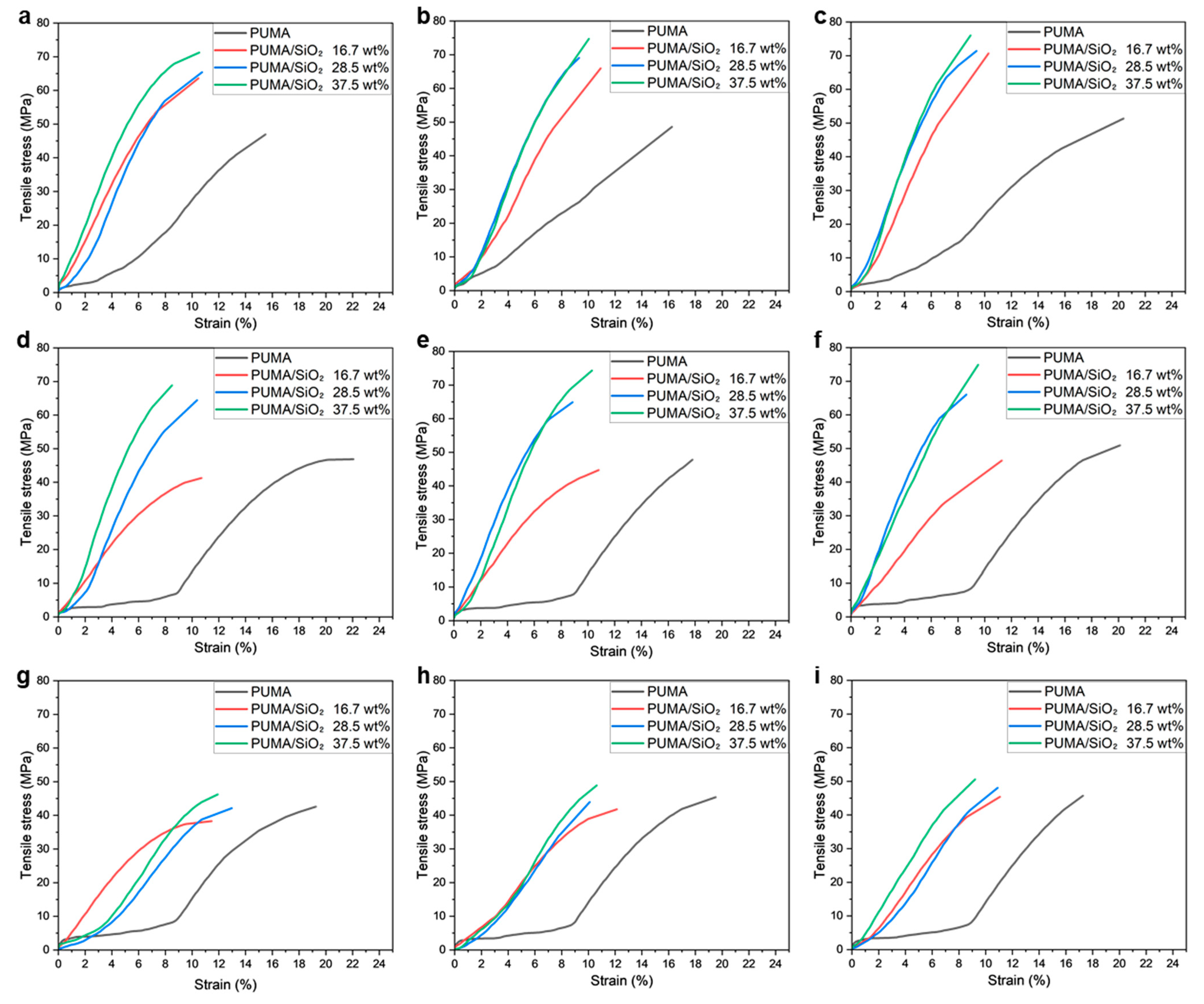

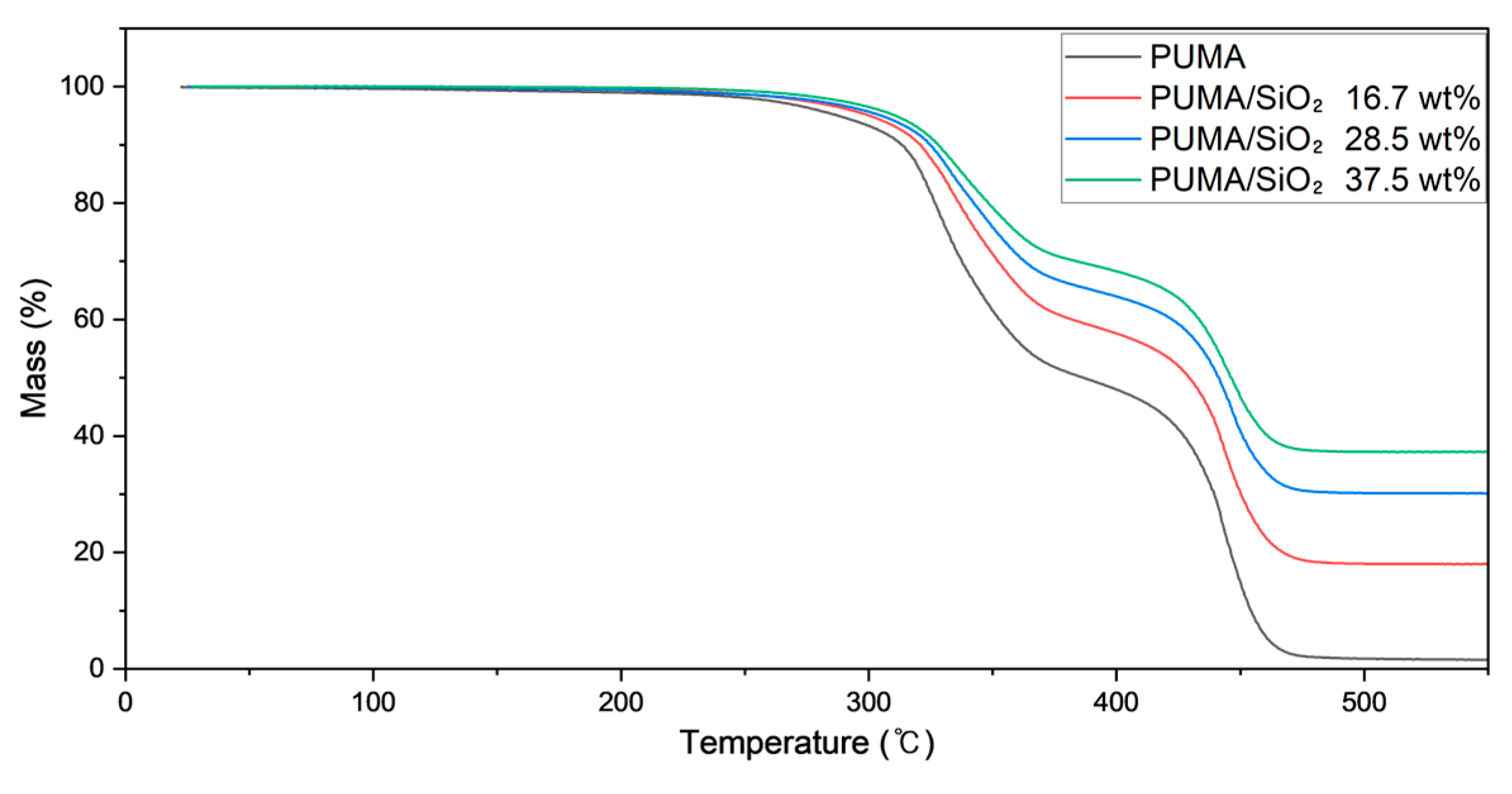

| SiO2 Content | Volume (cm3) | Mass (g) | Density (g/cm3) |
|---|---|---|---|
| 0 wt% | 3.174 ± 0.009 | 3.483 ± 0.005 | 1.097 ± 0.002 |
| 16.7 wt% | 3.168 ± 0.013 | 3.748 ± 0.014 | 1.183 ± 0.002 |
| 28.5 wt% | 3.138 ± 0.138 | 4.045 ± 0.006 | 1.289 ± 0.006 |
| 37.5 wt% | 3.170 ± 0.006 | 4.204 ± 0.019 | 1.326 ± 0.004 |
| SiO2 Content | α (mm2/s) | k (W/m-K) | Cp (J/g-K) |
|---|---|---|---|
| 0 wt% | 0.118 | 0.194 | 1.435 |
| 16.7 wt% | 0.147 | 0.236 | 1.279 |
| 28.5 wt% | 0.156 | 0.256 | 1.252 |
| 37.5 wt% | 0.173 | 0.281 | 1.174 |
Disclaimer/Publisher’s Note: The statements, opinions and data contained in all publications are solely those of the individual author(s) and contributor(s) and not of MDPI and/or the editor(s). MDPI and/or the editor(s) disclaim responsibility for any injury to people or property resulting from any ideas, methods, instructions or products referred to in the content. |
© 2024 by the authors. Licensee MDPI, Basel, Switzerland. This article is an open access article distributed under the terms and conditions of the Creative Commons Attribution (CC BY) license (https://creativecommons.org/licenses/by/4.0/).
Share and Cite
Kang, J.; Park, S.H.; Park, K. Enhanced Mechanical Properties of PUMA/SiO2 Ceramic Composites via Digital Light Processing. Polymers 2024, 16, 193. https://doi.org/10.3390/polym16020193
Kang J, Park SH, Park K. Enhanced Mechanical Properties of PUMA/SiO2 Ceramic Composites via Digital Light Processing. Polymers. 2024; 16(2):193. https://doi.org/10.3390/polym16020193
Chicago/Turabian StyleKang, Jiwan, Seong Hyeon Park, and Keun Park. 2024. "Enhanced Mechanical Properties of PUMA/SiO2 Ceramic Composites via Digital Light Processing" Polymers 16, no. 2: 193. https://doi.org/10.3390/polym16020193





